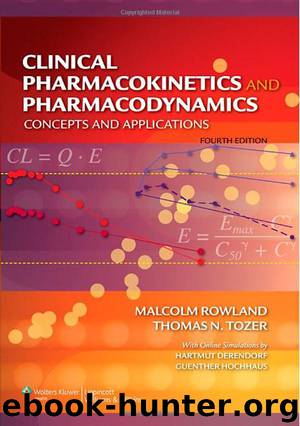Clinical Pharmacokinetics and Pharmacodynamics: Concepts and Applications by Rowland Malcolm & Tozer Thomas N

Author:Rowland, Malcolm & Tozer, Thomas N. [Rowland, Malcolm]
Language: eng
Format: azw3
Publisher: Lippincot (Wolters Kluwer Health)
Published: 2012-04-30T16:00:00+00:00
CARDIOVASCULAR DISEASES
Circulatory disorders, which include shock, malignant hypertension, and congestive cardiac failure, are generally characterized by diminished vascular perfusion to one or more parts of the body. Because blood flow may influence drug absorption, distribution, and elimination, it is not surprising that the pharmacokinetics of drugs may be altered in circulatory disorders.
A diminished perfusion of absorption sites (e.g., gastrointestinal tract and muscle) with associated protracted and erratic drug absorption, tends to be seen in patients with depressed cardiovascular states; it may be necessary to give the drug intravenously if a prompt response is desired. However, in these conditions, the kinetics of distribution is also affected, with perfusion to many organs diminished. Exceptions are the brain and the myocardium, which consequently receive an increased fraction of an intravenous (i.v.) bolus dose, particularly in the earlier moments. For centrally acting and cardioactive agents, the rate of administration of a bolus dose to patients with circulatory depression must be tempered if the risk of toxicity is to be reduced. In these depressed circulatory states, cardiac output and therefore hepatic blood flow and, to a much lesser extent, renal blood flow are also reduced. Thus, a decrease in clearance of highly extracted drugs is expected. Evidence supporting this concept is illustrated in Fig. 15-4 by a strong positive correlation between the clearances of lidocaine, a drug eliminated hepatically by metabolism, and indocyanine green, a diagnostic agent rapidly picked up by active transporters within the liver, and excreted into bile, in patients with varying degrees of congestive cardiac failure. Both indocyanine green and lidocaine are high hepatic extraction ratio drugs whose clearances should therefore reflect a diminished hepatic blood flow. Notice in Fig. 15-4 the almost 16-fold variation in clearance of both lidocaine and indocyanine green. This range is almost certainly greater than the range of hepatic blood flows in these patients. The hepatic flow, usually about 18 mL/min per kilogram, is unlikely to fall to a value as low as 2 mL/min per kilogram, because severe anoxia is expected to result at even higher flow rates. Hepatocellular metabolism and transport are most probably also depressed when perfusion is severely diminished; this would further depress the clearances of both lidocaine and indocyanine green. Exposure to lidocaine is increased in patients with congestive cardiac failure, and the risk of toxicity is therefore increased.
Download
This site does not store any files on its server. We only index and link to content provided by other sites. Please contact the content providers to delete copyright contents if any and email us, we'll remove relevant links or contents immediately.
| Administration & Medicine Economics | Allied Health Professions |
| Basic Sciences | Dentistry |
| History | Medical Informatics |
| Medicine | Nursing |
| Pharmacology | Psychology |
| Research | Veterinary Medicine |
The Poisoner's Handbook by Deborah Blum(1984)
Bottle of Lies by Katherine Eban(1707)
Mycelium Running: How Mushrooms Can Help Save the World by Paul Stamets(1584)
The Vaccine Race by Meredith Wadman(1564)
Missing Microbes by Martin Blaser(1522)
Pharmacy Practice and The Law by Richard Abood(1496)
The Doors of Perception and Heaven and Hell by Aldous Huxley & Aldous Huxley(1491)
Decisive by Chip Heath(1458)
Steroids: History, Science, and Issues by Standora Joan E.; Bogomolnik Alex; Slugocki Malgorzata(1428)
28 Seconds by Michael Bryant(1422)
The Doors of Perception: Heaven and Hell (thINKing Classics) by Aldous Huxley(1414)
McGraw-Hill Nurses Drug Handbook by Patricia Schull(1403)
Ganja Yoga by Dee Dussault(1388)
What's Making Our Children Sick? by Michelle Perro(1352)
Complete Guide to Prescription & Nonprescription Drugs 2014 by H. Winter Griffith(1283)
Stealing Fire: How Silicon Valley, the Navy SEALs, and Maverick Scientists Are Revolutionizing the Way We Live and Work by Steven Kotler & Jamie Wheal(1278)
Anatomy of an Epidemic by Robert Whitaker(1239)
Trip by Tao Lin(1235)
Cannabis for Chronic Pain by Rav Ivker(1167)
